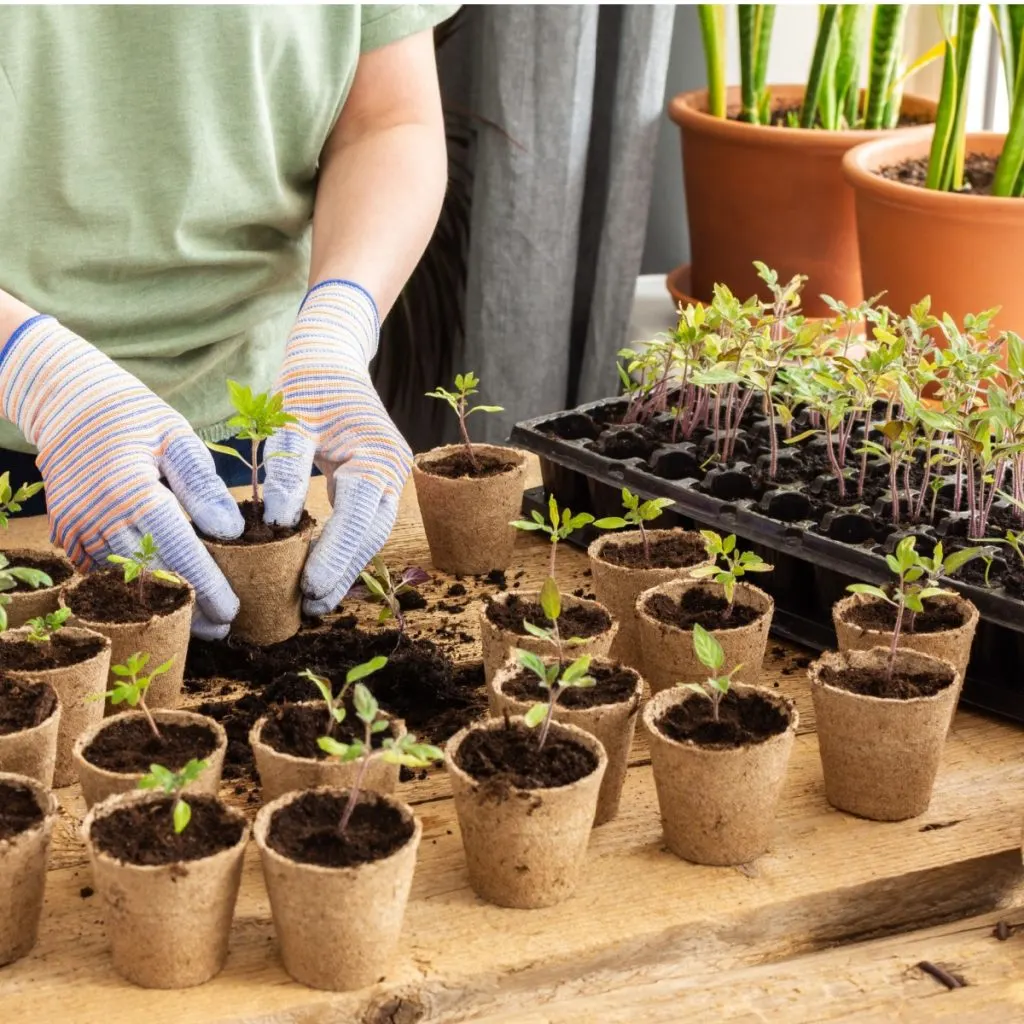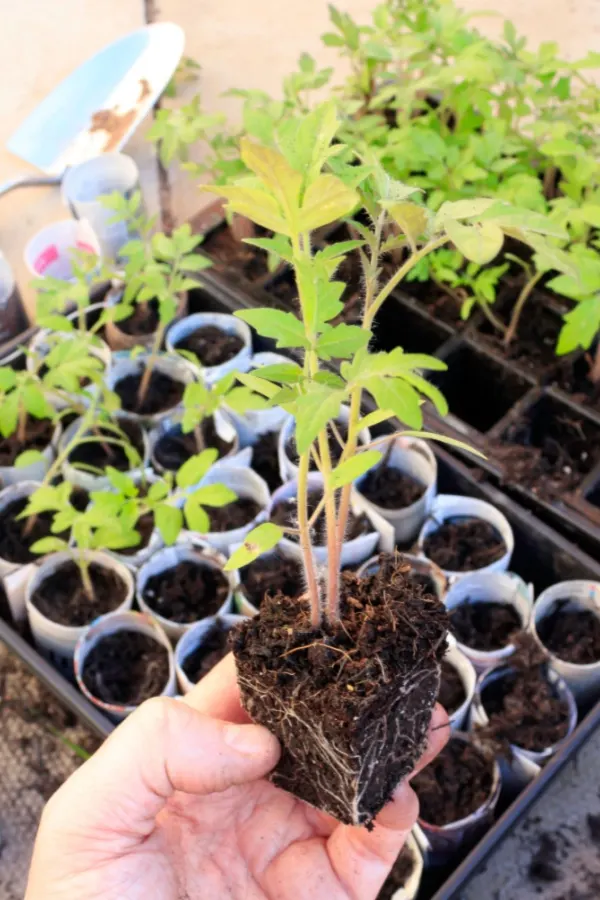Need to transplant your tomato seedlings into a larger container – and fast? When tomato seedlings are growing so fast and so tall that they are drooping over and the soil is nearly impossible to keep moist, it’s a sure sign that it’s time to transplant them before they begin to suffer!
Depending on the size of your seed starting trays, this might need to be done as early as within the first month of new growth. However, if you use seed starting trays with larger cells, you may be able to wait a little longer before transplanting them into bigger pots.
Because there are so many different variables when it comes to growing conditions, there isn’t a definite timeline for when to move small tomato seedlings. However, there are obvious signs that will indicate when it needs to happen.

When To Transplant Tomato Seedlings Into Large Containers
Transplanting tomato seedlings into larger pots at the right time is crucial to promote strong and healthy growth. So when do you know when need to transplant? There are actually several key signs to look for – all of which indicate that it’s time to transplant them.
Key Signs It’s Time To Transplant Your Tomato Plants
Fast Water Drainage
The first indication that you need to repot tomato seedlings is if you find yourself needing to water plants more than once a day. When the soil dries out too quickly or is unable to absorb the water adequately, it’s likely due to the roots taking up most of the available cell space. And at that point, they simply need more room to grow.
Wilting or Yellowing Leaves
You may notice that the lower leaves of the seedlings are wilting or turning yellow. Although this could be an indication of overwatering, it may also be a sign that the roots are too large. Once they are too big they are unable to take up nutrients efficiently, and when that happens, the leaves are the first to suffer.
Stunted Growth
Have your seedlings stopped growing? Or are they growing very slowly despite proper care and adequate light? If so, it’s time to transplant the tomato seedlings into a larger container where the roots can continue to expand.

Root Bound
Check the bottom of the current pot. Do you see roots circling around the bottom or poking out of the drainage holes? This is an indicator that the plant’s roots are too big for their space, and the plant is beginning to become root bound.
Heavy Top Growth
Finally, if your seedlings growing vigorously and have developed a strong stem and healthy green leaves -but the tops are falling over, it’s a good sign that they are ready to be transplanted into larger pots where they can have more support.
What You Need To Transplant Tomato Seedlings
When it comes to how to transplant the tomato seedlings, there are a few key tips to follow to get your plants adjusted to their new surroundings. For starters, it’s always best to give your plants plenty of big room in their new container!
New containers should be at least double the size of what the tomatoes are currently planted in. This will allow enough depth to provide adequate stability and promote good growth.
Recycled flower pots or large individual yogurt containers, plastic soda and coffee cups with a drain hole cut into the bottom are all great options. However, be cautious if transplanting into a recycled flower pot. Before doing so be sure it is cleaned and sterilized to help prevent the spread of soil-borne diseases.

Just like when following planting your seedlings from the start, be sure to select a good quality seed starting soil for the larger pots. It should be light, well draining, and full of good nutrients to power the plants. See our article: How To Start Tomato Seeds Indoors
It’s important to avoid using regular garden soil, top soil, or even a heavy based potting soil. They simply don’t have enough ready-to-consume nutrients for young seedlings. Affiliate Product Link: Fox Farm Happy Frog Organic Potting Soil Mix
Once you have the lightweight potting soil mix it with generous amounts of worm castings and fine compost. Both will provide a much needed boost once you transplant the tomato seedlings into their larger container.
How To Transplant Tomato Seedlings Into Larger Containers
Now that you have the materials, it’s time to get those seedlings into their new and more spacious home. Start by lightly watering the seedlings a couple of hours before transplanting them.
This will help keep the original potting mix from falling away from the roots during transport. If the roots become exposed they are at a higher risk of damage.
When you are ready to transplant, place an inch or so of potting mix in the bottom of the container. Then lightly tamp down the mix to remove any large air pockets. Remove the seedling from its seed cell by pushing the root ball and soil up from the bottom of the cell.

Be sure to resist grabbing the transplant by the stem. Doing so can cause the stem to break. But even more importantly, it can also crush and bruise the fine root nodules that will eventually become part of the plant’s root base.
Once the plant is out of the seed starting cell, place it gently in the new container. If the soil is root bound, slightly pull the roots apart. Next, slowly add potting mix a little at a time. While you do, lightly tamp down each layer to remove air pockets which may allow the roots to dry out from not staying in contact with the soil.
Add enough potting mix to bury about two-thirds of the plant’s stem. When transplanting, always be sure to leave the top three sets of leaves above the soil. Then gently water the plants until the soil is moist but not soaked.
Don’t Forget To Fertilize Tomato Seedlings & Transplants
It’s important that once plants are in their new environment to continue to feed them with a low and slow dose of compost tea, worm casting tea, or a weakened commercial liquid fertilizer. Affiliate Link: Espoma Organic 16 Ounce Concentrated Tomato Plant Food
As for when to fertilize, it is best to apply the first dose when the seedlings are four weeks of age, regardless of the container that they are in. If you transplant to a larger container, wait about one week before fertilizing again.

Compost and worm casting tea can be used at full strength. Their nutrients will not burn or overpower young plants. However, if you use a liquid organic fertilizer, always dilute to about 1/4 strength. At full dose, it is simply too strong and can actually injure or even kill young plants. If you are growing tomatoes in a greenhouse and need more information on getting your transplants ready to be planted in the ground, see How To Grow Tomatoes In A Greenhouse – The Simple Secrets To Success!
Here is to giving your young tomatoes the space they need to grow – and to growing your best tomato crop ever this year!
I Grow Tomatoes
Follow Our Facebook Page For Even More Great Tomato Growing Tips! I Grow Tomatoes Facebook Page
I Grow Tomatoes is a website created for those who love all things about tomatoes – from planting and growing – to cooking and canning! We publish two articles every week, 52 weeks a year. Sign up today to follow via email! This article may contain affiliate links.
